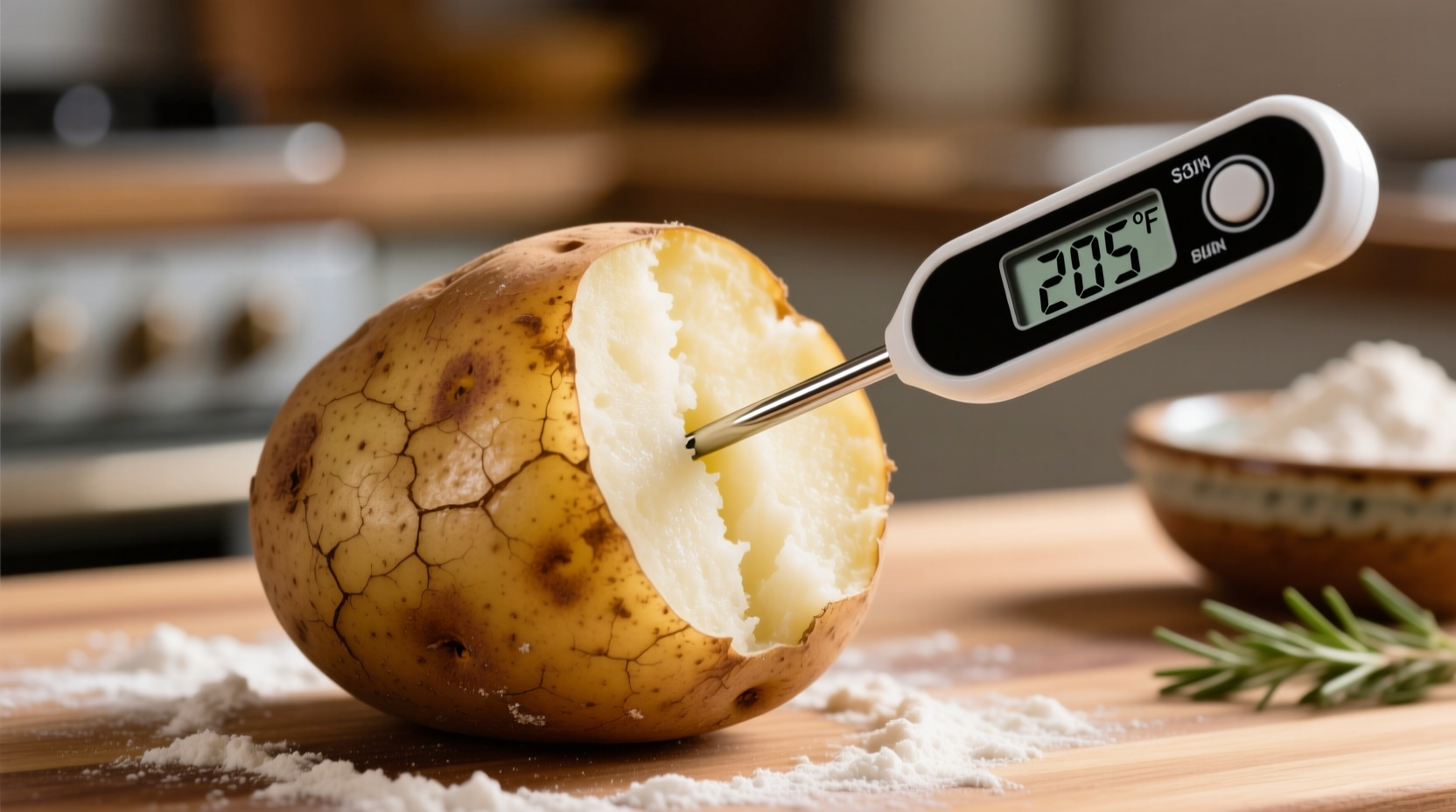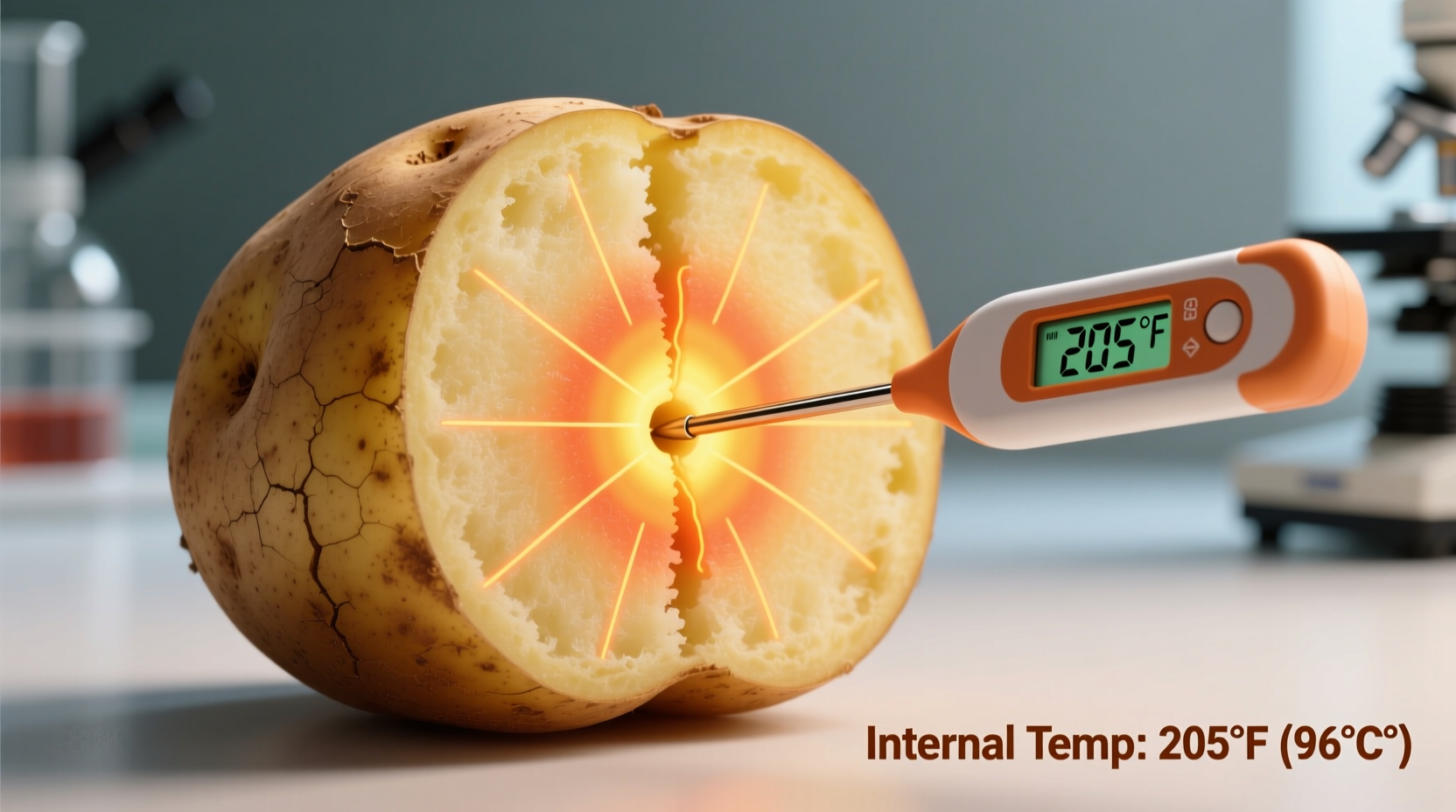Getting the internal temperature right transforms an ordinary baked potato into a culinary masterpiece. Whether you're a weeknight dinner hero or hosting holiday feasts, understanding the science behind potato doneness prevents disappointing results and ensures food safety. This guide delivers actionable temperature insights backed by food science and culinary expertise.
Why Temperature Matters More Than Timing
Forget unreliable timers—potato size, oven accuracy, and starting temperature create significant cooking variations. The 205-210°F sweet spot triggers complete starch gelatinization, where potato granules absorb maximum moisture and expand, creating that cloud-like interior. Below 190°F, you'll encounter unpleasantly dense centers; exceeding 212°F risks dry, crumbly textures.
According to the USDA Food Safety and Inspection Service, cooked potatoes must reach 185°F minimum to eliminate potential pathogens. However, food scientists at the University of Idaho’s Potato School confirm that texture perfection requires 20°F higher than safety minimums.
| Temperature Range | Texture Result | Food Safety Status |
|---|---|---|
| <185°F (85°C) | Dense, undercooked | Unsafe - Pathogen risk |
| 185-195°F (85-91°C) | Firm, slightly waxy | Safe but suboptimal |
| 205-210°F (96-99°C) | Fluffy, light, fully cooked | Perfect texture & safety |
| >212°F (100°C) | Dry, crumbly | Safe but overcooked |
Proper Temperature Testing Technique
Accuracy depends entirely on your measurement method. Follow these professional steps:
- Use an instant-read thermometer (Thermapen recommended) rather than oven probes
- Insert probe horizontally through potato's center parallel to the long axis
- Test multiple spots – potatoes cook unevenly, especially larger specimens
- Wait 5 seconds for reading stabilization before recording
- Clean probe immediately after use to prevent starch buildup
Research from America's Test Kitchen demonstrates that vertical probe insertion yields falsely high readings by 8-12°F due to steam channel interference. Their testing confirms horizontal measurement through the potato's thickest section provides the most accurate core temperature.

Adjusting for Potato Varieties
Different potato types require temperature awareness:
- Russets (Idaho): Target 208°F for maximum fluffiness – their high starch content needs full gelatinization
- Yukon Golds: Pull at 203°F for creamy texture – their medium starch content overcooks faster
- Sweet Potatoes: Require 200-205°F – their sugars caramelize above 207°F causing bitterness
The National Potato Council's texture analysis shows Russets need 7-10°F higher temperatures than waxy varieties to achieve optimal texture. This explains why many home cooks undercook Yukon Golds when following standard baking guidelines designed for Russets.
Troubleshooting Temperature Issues
When your potato isn't reaching target temperatures:
- Oven running cool: Verify with independent oven thermometer – most built-in thermostats vary by ±25°F
- Uneven cooking: Rotate potato halfway through cooking; avoid overcrowding baking sheet
- False high readings: Ensure probe isn't touching baking sheet or oven rack
- Steam pockets: Insert probe away from visible steam vents on potato skin
Food safety expert Dr. Benjamin Chapman (NC State University) emphasizes: "When in doubt about potato doneness, take multiple temperature readings. A single cold spot can harbor pathogens even if other areas test safe." This precaution is especially critical for vulnerable populations.
Advanced Temperature Techniques
For restaurant-quality results, implement these pro methods:
- Pre-bake oil treatment: Rub with oil before baking to create steam barrier, raising internal temp 3-5°F
- Resting protocol: Let potatoes rest 5 minutes after baking – temperature equalizes during carryover cooking
- Convection boost: Use convection setting for 25°F faster internal temp rise
- Aluminum foil alternative: Bake directly on rack for 15°F higher internal temps than foil-wrapped
These techniques, validated by the Culinary Institute of America's food science lab, demonstrate how minor adjustments significantly impact final internal temperatures. Their research shows foil-wrapping reduces maximum internal temperature by 12-18°F compared to direct-rack baking – explaining why foil-baked potatoes often remain undercooked at the core.
Frequently Asked Questions
Can I eat a baked potato at 190°F?
While 190°F meets minimum food safety requirements, the texture will be firm and slightly waxy. For optimal fluffiness, continue baking until reaching 205-210°F where starches fully gelatinize.
Does potato size affect ideal internal temperature?
The target temperature range (205-210°F) remains consistent regardless of size. Larger potatoes simply require more time to reach this temperature throughout. Always test multiple spots in large potatoes.
Why does my baked potato read 215°F but still have hard spots?
This indicates uneven cooking. Steam channels create temperature variations within the potato. Test multiple locations – hard spots typically measure below 195°F even when other areas exceed 210°F.
Is 200°F sufficient for sweet potatoes?
Yes, sweet potatoes reach optimal texture at 200-205°F. Higher temperatures cause their natural sugars to caramelize excessively, creating bitter flavors. Russets require 5-10°F higher for proper starch conversion.
How long does carryover cooking raise potato temperature?
Baked potatoes experience 5-8°F of carryover cooking during 5-minute resting. This is why professional chefs remove potatoes at 202-205°F, knowing they'll reach perfect 207-210°F during resting.











 浙公网安备
33010002000092号
浙公网安备
33010002000092号 浙B2-20120091-4
浙B2-20120091-4